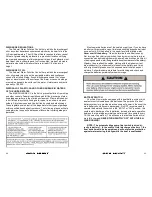
34
VOLTMETER
The voltmeter (optional) indicates the battery charge with the en-
gines off and the charging system output with the engine running. A
reading of 12 or 13 volts with the engines off is normal, indicating a
fully-charged battery. Readings below 11 indicate a weak battery
which may not start an engine. A reading of 13 to 15 volts when the
engine is running is normal. Readings over 15 volts may indicate
regulator problems. Low or fluctuating readings may indicate loose
connections or trouble in the regulator and alternator circuit.
ENGINE LUBRICATION
4-STROKE ENGINES
Your Yamaha 4-stroke engine is equipped with an engine oil sys-
tem similar to an automobile. Sea Hunt factory rigged engines have
been filled with the correct amount and type of oil upon installation.
The owner should check the oil condition and level after the first few
hours of operation, and follow a routine oil change schedule as recom-
mended in your engine manual.
WARNING SYSTEMS
WATER TEMPERATURE AND OIL LEVEL
Outboard engines have several warning systems. The buzzer for
these systems is located under the dash. Some models also have
indicator lights in addition to the audible alarm. The purpose of the
buzzer is to alert the driver to potentially damaging engine operating
conditions. Consult your engine owner’s manual for exact location
and function of these systems.
Yamaha engine warning systems also incorporate an RPM reduction
mode that when working properly effectively controls the engine RPM.
The maximum RPM achievable when a Yamaha warning system is acti-
vated is 2,500 RPM. Consult your authorized dealer if your engine is not
achieving proper operating RPM.
YAMAHA DIGITAL ENGINE INSTRUMENTATION
(Optional)
LCD MULTI-FUNCTION TACHOMETER
The Yamaha LCD Multi-function Tachometer incorporates a Ta-
chometer, Trim Gauge, Total Hour Meter, Trip Hour Meter, Oil Indica-
tor, Overheat light.
LCD MULTI-FUNCTION SPEEDOMETER
The Yamaha LCD Multi-function Speedometer incorporates a
Speedometer, Fuel Gauge and Volt Meter. The gauge is compatible
with most GPS units.
31
Reverse Throttle:
To engage the throttle mechanism in reverse
continue to move the lever forward (back or aft) past the detent in a
controlled motion. This motion will begin to increase engine RPM
which will cause the boat to move backwards.
Neutral Throttle:
To engage the neutral throttle function on your
Yamaha control box depress the neutral lockout button located at the
center of the control lever’s pivot point. While fully depressing the but-
ton inward move the control forward or reverse to activate the throttle.
STOPPING / BRAKING
To stop a boat that is moving forward you may reverse the shift
mechanism. This change in direction will provide a “braking action,”
slowing the boat.
CONTROL CABLES
If your throttle or shift cables need replacing use the same style
and length as the original equipment.
STEERING
Most outboard engines are equipped with an adjustable rudder
trim tab. This trim tab should be adjusted to balance the steering at
the speed which you travel most frequently. Variations in speed, boat
load or changes in the engine trim will cause the steering to pull in
one direction. If the boat pulls to the left adjust the trim tab to the left
and vice-versa.


































